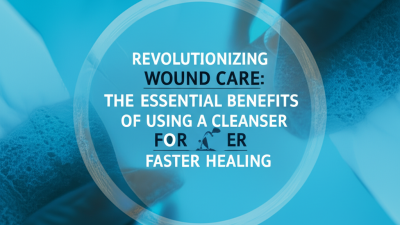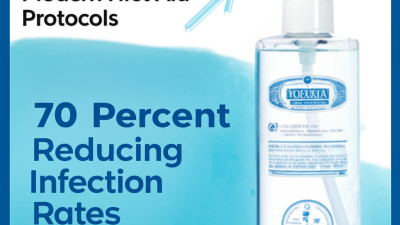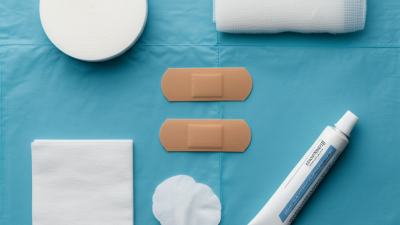Revolutionizing Wound Care: The Essential Benefits of Using a Cleanser for Faster Healing
In the rapidly advancing field of wound care, the integration of effective cleaning solutions has become paramount to ensuring optimal healing outcomes. A recent report from the World Health Organization highlights that improper wound care not only extends healing time but also significantly increases the risk of infections, underscoring the necessity for reliable cleansing methods. Wound care cleansers have emerged as essential tools in this scenario, designed to remove debris and pathogens while promoting a moist healing environment. According to a study published in the Journal of Wound Care, patients using a specialized "Wound Care Cleanser" experienced 30% faster healing times compared to traditional methods. These statistics illustrate the critical role that proper cleansing plays in modern wound management, revolutionizing care practices and paving the way for improved patient outcomes.

Benefits of Using Specialized Cleansers in Wound Care
In the realm of wound care, the choice of cleanser can significantly impact the healing process. Specialized cleansers are designed to gently cleanse wounds while promoting a conducive environment for healing. These formulations often contain ingredients that not only remove debris and bacteria but also help maintain moisture levels, which is crucial for tissue regeneration. Using an appropriate cleanser minimizes the risk of infection and accelerates healing by creating optimal conditions for the body’s natural repair mechanisms.
Additionally, many specialized wound cleansers are formulated with pH-balanced components that support the skin’s natural barrier. This balance is essential in preventing irritation and protecting delicate tissues surrounding the wound. Furthermore, some cleansers include antimicrobial properties that safeguard against pathogenic organisms, reducing the chance of complications that can delay recovery.
Incorporating these specialized cleansers in wound management can lead to improved patient outcomes, enhancing the overall wound healing process.
The Role of pH Balance in Promoting Optimal Healing
Maintaining the proper pH balance of a wound environment is crucial for optimal healing. The skin's natural pH typically ranges from 4.5 to 5.5, indicating a slightly acidic state. This acidity plays a significant role in various physiological processes, including inflammation control, prevention of infection, and promotion of cellular regeneration. When wounds are managed with a cleanser that supports this natural pH, they create a conducive environment for tissue repair, reducing the time needed for healing significantly.
Using a cleanser specifically designed to respect the pH balance prevents the disruption of the skin's protective barrier. Alkaline cleansers can lead to an unfavorable environment, promoting bacterial growth and delaying the healing process. In contrast, pH-balanced cleansers help to maintain the natural flora, providing antibacterial properties while aiding in the removal of debris and exudates from the wound site. This supportive role of pH balance cannot be overstated, as it not only enhances healing rates but also minimizes the risk of complications, ensuring a faster and more effective recovery.
Comparison of Traditional Wound Cleansers vs. Modern Solutions
When it comes to wound care, the choice of cleanser plays a pivotal role in promoting faster healing. Traditional wound cleansers, often saline-based, have long been the standard; however, they may not always provide the necessary antibacterial and debriding action required for optimal recovery. According to a 2021 report published by the World Health Organization, more than 80% of wound infections can be traced back to inadequate cleansing methods.
In contrast, modern wound care solutions, such as enzymatic cleansers and antiseptic solutions, provide a more effective option for managing wounds. Research indicates that these modern alternatives can decrease healing time by up to 30%, minimizing the risk of infection and promoting a healthier healing environment. These advanced formulations often include ingredients that not only cleanse but also stimulate tissue regeneration and support the inflammatory process.
**Tips:** When selecting a wound cleanser, consider the type of wound you are dealing with. For chronic or infected wounds, opt for products specifically designed to debride and promote healing. Make sure to follow the manufacturer’s instructions for proper application, as this can significantly influence the healing outcome. Additionally, consulting with a healthcare professional can help tailor the wound care approach to individual needs, ensuring the best possible recovery.
Revolutionizing Wound Care: The Essential Benefits of Using a Cleanser for Faster Healing - Comparison of Traditional Wound Cleansers vs. Modern Solutions
| Wound Cleanser Type | Speed of Healing (Days) | Infection Rate (%) | User Comfort (1-5) | Cost per Use ($) |
|---|---|---|---|---|
| Traditional Saline Solution | 10 | 15 | 3 | 0.50 |
| Antiseptic Solution | 8 | 10 | 4 | 1.00 |
| Hydrogel Cleanser | 6 | 5 | 5 | 1.50 |
| Iodine-based Cleansers | 7 | 8 | 4 | 1.20 |
| Modern Bioactive Cleanser | 5 | 3 | 5 | 2.00 |
Understanding the Impact of Bacteria Removal on Healing Time
The role of bacteria in wound healing is crucial, as their presence can significantly impact the recovery process. When a wound occurs, harmful bacteria can infiltrate the damaged area, leading to infection. An infection not only delays healing but can also cause complications that further hinder recovery. By effectively removing bacteria from the wound site with a suitable cleanser, patients can create a more favorable environment for healing to occur.
Using a specialized wound cleanser can dramatically reduce the bacterial load and mitigate the risk of infection. These cleansers often contain antimicrobial agents that target and eradicate harmful microorganisms without damaging healthy tissue. As a result, wounds that are cleaned regularly with appropriate solutions tend to heal faster and more efficiently. Moreover, minimizing bacterial presence lowers the chances of chronic wounds, which are a significant concern in long-term care settings. By prioritizing proper cleansing, individuals can enhance their healing process and promote quicker recovery.
Incorporating Cleanser Use into Daily Wound Management Practices
Incorporating cleanser use into daily wound management practices is crucial for promoting faster healing and preventing infection. Cleaners specifically designed for wound care can effectively remove debris, bacteria, and dead tissue, creating an optimal environment for healing. By integrating these cleansers into everyday routines, patients can ensure their wounds are consistently kept clean, reducing the risk of complications and enhancing recovery times.
Moreover, establishing a regular cleansing schedule helps to reinforce the importance of wound care in patients’ daily lives. Educating individuals on how to properly apply a cleanser, including the importance of gentle techniques and the timing of applications, can empower them to take an active role in their healing process. When patients adopt a proactive approach to wound care, supported by the use of effective cleansers, they not only foster quicker recovery but also increase their overall confidence in managing their health.
Impact of Cleanser Use on Wound Healing Time
Related Posts
-

Finding Top Suppliers for Best Wound Cleansing Solutions in the Global Market
-

The Essential Role of Wound Cleanser in Modern First Aid Protocols with 70 Percent Reducing Infection Rates
-

Understanding the Importance of Quality Wound Care Supplies for Effective Healing
-

Top 10 Wound Care Supply Manufacturers from China at the 137th Canton Fair
-

Innovative Wound Dressing Solutions at the 138th Canton Fair 2025 Unveiling Industry Trends
-

How to Optimize Your Healing Process with Wound Healer Techniques
